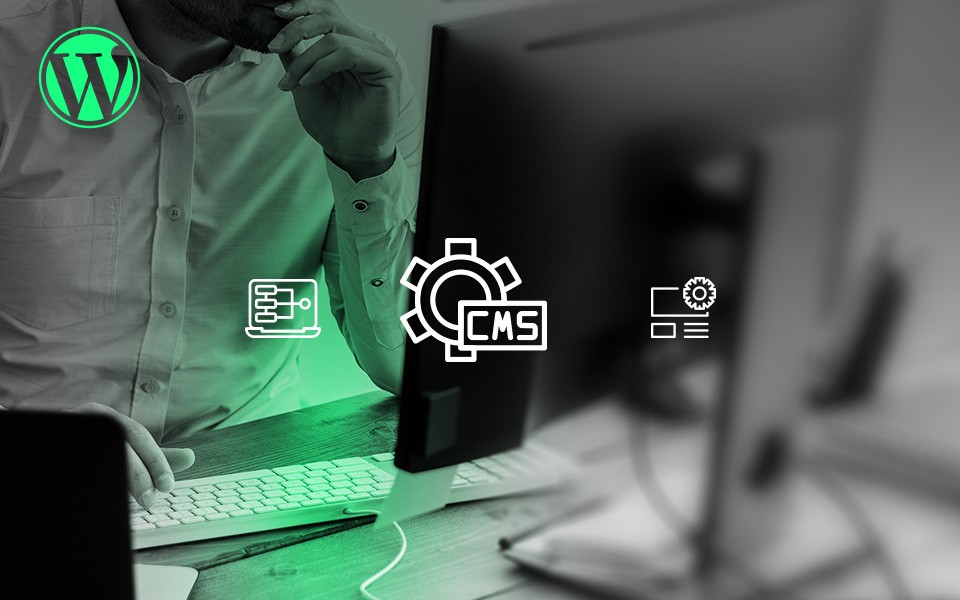 Back to blog
Back to blog
What is Headless WordPress? A complete guide for beginners

Content Management Systems are powerful and can become even more so if they go headless. What is it? Is it an option that you should look into? With the growing number of digital channels available and customer expectations always on the rise, Headless CMS has become a perfect content management solution that you should get familiar with. Read our guide to find out more.
What is a Headless CMS?
To define Headless CMS, we’ll first decompose the term. CMS stands for Content Management System, used to create, store and organize content, such as blog posts, images, or videos.
Traditionally in the website, users see an interface of the page when they visit (front-end), and the back-end is responsible for storing and managing data (you’d use it to add new content and features and customize styles). So, in other words – in the traditional CMS, you have a database of content permanently linked to the template. Well, the “headless” option is designed differently. When the CMS is “headless,” it means that the back-end content repository (body) is separated from the front-end layer (head).
Traditional vs. Headless CMS
In the traditional (also known as monolithic) CMS, you can create, edit and store content in one system. Typically, you would choose themes and plugins and customize the web pages’ look with an easy-to-use “What You See Is What You Get” (WYSIWYG) editor. For example, you could access the admin dashboard, use a drag-and-drop interface to edit a post, preview, and publish it with a few clicks. In this case, you don’t need advanced technical skills to develop a site, but you are dependent on your CMS to display the content. This complicates publishing on many different platforms, so if you want to place your content on the website and Facebook, mobile app, smartwatch, and Wikipedia, Headless CMS gives you the flexibility to do that. Why? Because it removes the front-end (chops the head off, so to speak) and lets you develop it with your chosen code. The back-end can then be used regardless of the language used for the display layer.
Before we get into how this solution actually works, let’s quickly make one thing clear – if you hear the terms “headless” and “decoupled” WordPress used interchangeably, know there is a difference between the two. In the “decoupled” version front and back-end are detached (albeit connected via the API), and they function independently, allowing you to change the presentation without altering the code. Nevertheless, the front-end remains included in the overall system, and its architecture is pre-defined and determined by the particular presentation environment.
When CMS is headless, it lets you deliver content to any platform you want because the front-end layer does not dictate the back-end.
Headless WordPress – how does it work?
OK, so we talked about Content Management Systems in general, but let’s focus on the most popular one that overtook a significant chunk of the market – WordPress. In 2016, WP 4.7 was released, with the REST API enabled by default. We need to understand what REST API is to grasp the essence of Headless WordPress.
We’re talking here about the application programming interface (API), which is a piece of software that allows applications to communicate with each other. The Representational State Transfer (REST) API allows external applications to access content in the form of row data from WordPress, thus allowing developers to integrate WP with third-party apps and sites. Why is that element of software important? Because it’s the REST API that calls for the content stored in the back-end and pushes it to your preferred platforms and devices. This means that you can use the REST API to make the content available across many websites and channels.
Freedom to create any display layer you want also means that you have to put thought and time into this project. To build fast, adaptable web pages and ensure the efficiency of the headless front-end, you should choose the right coding language and framework (such as React JS, Gatsby JS, Vue JS, Angular JS, or the Foundation).
Is Headless the right solution for you?
Sure, traditional CMS is more limiting, but that doesn’t mean that the headless option is for everyone, especially if you lack in-house technical resources, the external developer’s or agency’s support. There are, however, some scenarios where the business can definitely benefit from the headless architecture.
- You want your unique sites to be displayed on many different devices.
- You want more control over SEO, site structure, and content view.
- You prefer to update content in one place but publish it across multiple channels.
- You manage sub-brands promoted across multiple websites.
- Content creation is your primary goal, and you would like to develop, post, and edit it daily without involving the technical team.
- Your preference is to use custom tools that don’t integrate with traditional CMS.
- You manage e-commerce platforms and offer a variety of products and services.
- You’re in the industry facing complex content requirements and frequent updates, such as, for example, airlines, financial services, or, as mentioned, retail.
- Technical freedom is important to you, and you don’t want to be limited by any system or coding language.
Still not sure whether this is a good option for you? Let’s go through the benefits and downsides of using Headless WordPress.
that you can change
your business.

Headless WordPress Pros
If you are to give up on the convenience of traditional WordPress, you must have a good reason to do it. Below we mention some arguments for applying the headless solution that may sound convincing.
Omnichannel support: With the headless option, you’re not tied to the specific display of the website, nor are users limited to accessing content only from web pages anymore. Going outside the WordPress sphere significantly improves scalability – you can quickly deploy content to mobile apps, smartwatches, digital assistants, IoT devices, and many more.
Multiple ‘heads’: if you’re an organization with multiple websites or active on various channels, you can manage your outputs via several ‘heads’ and only one back-end. Moreover, you don’t have to worry about making changes to each product and service separately for different platforms – with a headless solution you can simply update it in one place.
Improved performance: Feature-rich WordPress front-end is not always as fast as we wish. Plugins and themes (mainly unused ones) only weigh the system down, and obviously, nowadays, you can’t ask the users to patiently wait for the page to load. Slow page rendering in the traditional CMS also negatively impacts user experience. REST API will allow for a much faster rendering of the content. And if you want to revamp or even rebuild the front-end, you can easily do it without introducing changes to the code and re-uploading old content.
Front-end flexibility: WordPress in its traditional form is a great platform, it really is. Flexible, customizable, with an abundance of themes and plugins on offer. But it can always be better, and getting rid of templates and add-ons is part of the answer. Perhaps you don’t want to be limited by WordPress systematic solutions and would instead outsource the front-end to another software. Now you can. The headless option gives your developer complete creative freedom, which both himself and your business will appreciate.
Headless WordPress challenges
As always, everything in life comes at a cost. (Also financial in case of Headless WordPress, but more on that later). Traditional CMS has been used for years, and the whole ecosystem was developed around it. When going headless, you need to abandon familiar tools and technologies and face some shortfalls as a result:
You need a developer’s help: One of the significant benefits of WordPress has always been that it’s easy to use, even for clients lacking technical knowledge. Implementing headless solutions means saying goodbye to the code-free experience. Welcome back, developers! We now need you more than ever to create scalable code and build a unique customer experience. With the headless architecture being way more complex than in the traditional CMS and often the necessity to develop your own front-end, this is not a solution for technical newbies. Moreover, relying on technical support for maintenance and implementation of changes may extend the time before updates appear on the website.
Editing may become a challenge: In the headless option, you don’t see the front-end the same way the user does. The lack of live preview makes daily content management much more difficult unless done by someone with experience in coding.
You will need to invest more: We’re talking about time and money. Instead of one easy-to-maintain system that WordPress is, you now have to look after several. You will need to develop front-end and code system-specific plugins. Implementing your own solutions means that you must ensure continuous code maintenance, which is time-consuming as well as costly.
You should weigh the pros and cons and consider your expectations towards the channels and platforms you want to cover. Remember, though, that nowadays, with a multitude of devices and platforms available to users, going omnichannel is a necessity rather than an option. And Headless WordPress is a solution made for omnichannel.
How to create a Headless WordPress site
By now, you have probably made the decision and the vision of going headless lured you in. What’s next, then? There are two methods you can use to start working with this solution.
Use a plugin
WordPress is famous for its never-ending list of available plugins, so why not use one of them to turn it into a Headless CMS. Plugins will surely make your work easier, although technical knowledge is still required to build the front-end and make requests for API. For example, thanks to WP Headless, which removes the site’s front-end, you can set up WP as a Headless CMS. WPGraphQL is a noteworthy plugin that separates CMS from the display, allowing developers to use GraphQL (an open-source data query language for APIs created by Facebook). And if you’re interested in launching a store on multiple platforms, you can try the CoCart plugin that puts the Headless API on top of the WooCommerce back-end.
Manual setup
If you’re all about flexibility and don’t want to use an existing front-end, creating a Progressive Web App or coding the site yourself would be the best options. We think that with so many available products, it’s easier to learn a front-end framework compatible with WordPress (such as Gatsby or React mentioned before) than to build a new website from scratch.
Conclusion
The popularity of Headless CMS is constantly growing and will continue to be on the rise. With more and more channels and devices being used, there is more demand for this option. Not to mention that it’s attractive for developers who gain complete freedom to play around with various languages. Do you know what this flexibility means? Better solutions and improved user experience. OK, yes, you need to entrust the deployment and maintenance of a business into the hands of specialists, but working with experienced professionals in the field is not so bad. If you choose Develtio, we will ensure smooth and fast cooperation on projects that respond to your needs and create unique sites together.
What can we do for you?
Talk to us about your project and let's start building it together!








Autor
I first encountered the concept of Headless CMS in 2017 and immediately saw its huge potential. Since then, the Headless WordPress CMS dedicated tools have changed beyond recognition, reinforcing my belief that this architecture is the technology of the future.
The main advantage of Headless CMS is, of course, the separation of the back-end from the front-end part. Thanks to this, we gain great flexibility compared to standard solutions, and we can develop the components of the system independently of each other. Moreover, with the mentioned separation, creating successive versions of the front-end or, for example, mobile or progressive applications is easier than ever.
Headless CMS also brings significant value to end-users – by separating the components of the system, we gain speed, and a site created based on Headless CMS loads as fast as the regular static files placed on the server.